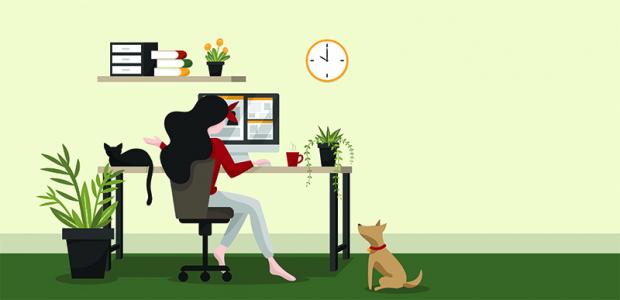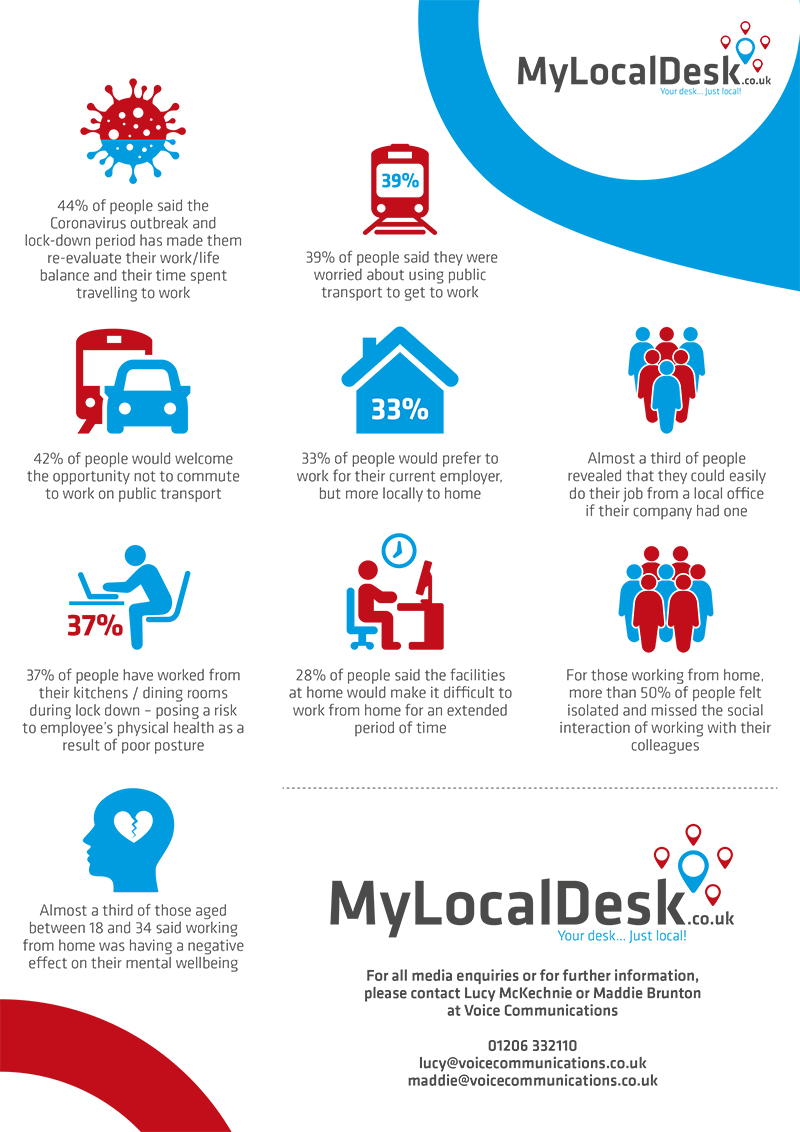
The changing face of the workplace
When (or indeed if) office-based employees make a return to work, now that lockdown restrictions are slowly beginning to ease, they are likely to find a very different world to the one they left behind. Startups, by their very nature, are inherently innovative, adaptable, flexible, and more willing than most to embrace change.
Therefore, founders and entrepreneurs should be well equipped to pivot in the very different post-COVID-19 world in which we will find ourselves. We take a look at the changing workplace landscape, ask what it will mean for entrepreneurs and small business owners, and what measures some startups are already putting in place.
The concept of ‘the office’ is now more abstract than ever as the lockdown period has pushed businesses (whether they wanted to or not) down the route of remote and home working, and the question now is whether the world of work will ever be the same.
Proof in the pudding is of course in the eating, and the ease with which some employees have adapted to remote working, and the speed with which they have upskilled their digital capabilities, has resulted in previously held fears and concerns of employers over remote working being quashed, and a real lack of desire amongst employees to return to the old norm. This has led some to suggest that the traditional office as we know it is dead.
Startups are of course at the forefront of this revolution. As mentioned previously, they are by nature more flexible, open to change, and less set in their ways than some more established businesses. Healthcare messaging startup Hospify, has had to combine the shift to remote working with a particularly busy time for the company. Co-founder James Flint commented: “The COVID-19 pandemic has had a big impact on Hospify. We’ve quadrupled our userbase since the UK lockdown started, seen our messaging volumes increase by more than 100x, and have made our first sales to NHS Trusts and surgeries as well as to private healthcare institutions. And of course, we’ve had to cope with all of this remotely.”
Filippo Yacob, Founder of digital piggy bank Pigzbe, explained that even prior to the lockdown, the company had grabbed the virtual bull by the horns and as such, were already ‘COVID-proof’.
Its development team had always been home-based, while the business unit were travelling most of the time. It therefore seemed cost-prohibitive to spend hundreds of thousands of pounds to rent office space, merely for the handful of people that were regularly commuting to the office to manage the admin side of the business.
Therefore, Pigzbe took the collective decision to go completely remote. Yacob commented: “Adapting to overcome the current crisis has not been that difficult, as all of our processes are COVID-proof anyway. It has been the best business decision of my life as a manager, and for everyone else in the business. Everybody is much happier and far more productive.”
Indeed, research has shown that an overwhelming 87% of employees would like to factor in more remote working post-lockdown, with 20% stating that they would like to work from home permanently. When asked what changes employees expect in the workplace of the future, they stated more flexibility to work from home (89%), more autonomy and trust (29%), and changes to work hours (18%).
Moving with the times
Platforms such as Zoom, Skype and Microsoft Teams are tailored to enable remote working and have emerged as business must-haves during the lockdown period. However, this technology has been at our fingertips for some time, and video conferencing is nothing new. Zoom, for example, is nearly ten years old. And advancements in technology and communications has seen ‘teleworking’ grow by as much as 175% since 2005.
Yet despite this, we are still pattern seeking creatures at heart and, for some old-school business owners, there is an innate and deep-rooted sense of security in doing things the way they’ve always been done, and as such, many will inevitably want to ditch the lockdown-enforced changes, revert to type and continue to base their staff in the office, despite there being no real practical requirement to do so.
Regardless of the unanimous agreement that productivity increased during lockdown, companies are still dubious about allowing more remote working once social distancing measures ease - citing concerns about employee productivity (64%), senior leadership preferring traditional ways of working (57%), and managers’ ability to oversee virtual teams (33%) as the main reasons for not wanting to continue with remote working.
However, it can’t be denied that coronavirus has well and truly torn up the workplace rule book for good. And the lockdown period has proven that employee output and productivity can be as good as (and in many cases better), than it is in an office-based environment. Domantas Gudeliauskas, Marketing Manager at website builder Zyro, commented: “With the help of Zoom and Google Hangouts, decisions can be made quickly, almost in the same time as it would take to walk across the office to talk to someone.”
This is to say nothing of providing employees with greater flexibility and a much-improved work/life balance, (to the extent that it may become something that workforces begin to demand from their employers).
Combine that with the elimination of commuting expenses and the subsequent impact on the environment, and it seriously calls into question the role the office has to play in the future, with new data showing that more than half of those currently working from home (59%) stating that working away from the office has changed their lives for the better; while 44% of people have claimed that the COVID-19 outbreak has made them re-evaluate their work/life balance and their time spent travelling to work.
Mark Pearcy, Head of Marketing at business telecommunications provider, 4Com, said: “The global health pandemic has completely transformed the way we live our lives, including the way we work. Remote working is set to be the future for many, and we expect employees to be looking at how their companies can better support home working from now on, especially when searching for new roles. Working from home has many benefits for employers and employees alike, including a happier workforce, which helps increase staff retention, and a more flexible way of life for workers to best fit in with their daily lives and schedules.”
Devil in the detail
Advertising agency, Adzooma, has recently conducted a survey of over 400 office-based workers on their individual experiences during lockdown, with startling results. Ninety-three percent of employees believe they can perform their role as normal from home; 83% enjoy it (with flexibility and lack of commuting cited as the main reasons); 67% of people said they were more productive; and 52% said they did not want to return to a normal office after the COVID-19 crisis.
It is of course different strokes for different folks, and remote working won’t be for everyone. It’s certainly true that some employees will feel they would lose out on the social aspect of their day-to-day work if they were based at home permanently, as Flint commented: “As the lockdown has dragged on even we have started to feel the shortcomings of being 100% remote. Apart from ‘Zoom fatigue’ and the boredom imposed by never leaving the house, the importance of the social side of work interactions has become very clear.”

However, the reverse side of the same coin is that the office environment can create distractions and interruptions which can impact productivity. Commenting as part of the survey, Chandell Gadbois, of New York-based staffing outfit Syfter, added: “I don’t see a need for the traditional office environment for the majority of companies, and personally believe it can often create situations where people are less productive on the whole. Working from home allows people to focus and get their work done, without ‘waiting for the clock to run out’ on their work day.”
Katie Holmes of community discussion forum, Outwit Trade added: “I love working from home. In fact, it is near impossible to go back to the office after this. The benefits of working from home simply blow the disadvantages out of the water. I would not return to an office as long as I have the option of working remotely.”
Tellingly, flexibility is one of the top-ranked work benefits amongst the millennial workforce. Pre-crisis, more than a third of employees (35%) would go so far as to change jobs if they had the chance to work from home, whilst over a third would take a pay cut of up to five percent in order to work at home some of the time.
A time to change
It could be argued that the drive towards greater remote working has been simmering below the surface for some time, with the coronavirus serving as the spark that ignites a blaze of change. In fact, a 2019 Owl Labs report (crucially conducted before the crisis), found that as many as 80% of employees wanted to work from home at least some of the time.
In what has been the world’s biggest remote working experiment, COVID-19 has revealed that while most firms have found the transition during lockdown seamless, it has nonetheless been rapid and dramatic. Only 11% of businesses stated that their whole workforce was able to work remotely pre-lockdown. However, this sky-rocketed amid COVID-19, with 70% of firms being able to push the button on remote working in less than a week.
Gone are the days when people lived and worked in the same town/district, and we are now a society that has been built around mobility and as such, the time taken to commute to work has risen steadily since the 1960s.
As the population has increased, and towns and cities have grown exponentially, there has been an increasing requirement to travel further distances to get to work. Over the years this has had a negative impact on work/life balance, increased congestion, and added to the strain on an increasingly creaking public transport system.
Beyond the practical benefits of increased flexibility and better quality of life for staff, plus reduced pollution, there are also significant business advantages to moving to a remote-based working structure, not least of which is a significant decrease in rental fees and utility bills.
In addition, a company that structures itself from a more virtual perspective can spread its net much wider when recruiting for experienced and talented staff, which is particularly useful in niche sectors. Rather than trawling a potentially small catchment area (which by definition will need to be within a certain mileage of the office), for a remote-based company the world truly is your oyster when trying to recruit the best staff. And for rapidly expanding startups that are increasing staffing levels quickly, the potential problem of outgrowing premises and having to move regularly is eliminated.
There is of course a bigger picture than offering a better quality of work/life balance for employees and saving a bit of money on rent (although they are by no means trivial issues). The lockdown period has had a marked impact on road congestion and on pollution levels. It is estimated that transport contributes 23% of global carbon emissions, and driving is by far the largest element of that, contributing 72% of transport emissions. However, since the coronavirus, China, the epicentre of the global virus outbreak, experienced a 25% drop in CO2 emissions. And the impact of statistics like these will likely influence the decision making of individual workers and businesses in the future.
Office redesign
It is important to remember that offices and workspaces have traditionally been designed to encourage collaboration and cooperation, and so the COVID-19 outbreak has not only been a disruption to the status quo, it has turned the concept of the office space completely on its head.
So, for the offices that do restart operations, they are likely to be a shadow of their former selves, with significant safety measures in place to essentially discourage a community feel in favour of prioritising staff safety, and understandably so. More commonplace will be staggered shift patterns and workstations, remote check-in, social distancing signage, limited occupancy of communal spaces (such as kitchens and breakout rooms), sneeze guards, reduction in shared equipment and stationery, touch-free doors and light switches, reduced lift capacity, and one-way corridors and travel around the office.
To make matters worse, those offices that do recall staff may be reluctant to turn on air conditioning systems for fears over air circulation. As we enter what are traditionally the hottest months of the year, the prospect of essentially going to work in a sauna is unlikely to make the daily commuting grind any more appealing for employees.
Crucially, these measures, in combination with rapid growth in the digital upskilling of employees, are unlikely to be temporary. The coronavirus has moved the goalposts, eschewing in a seismic shift in how we view the use of office spaces, with some predicting a 50% reduction in office occupancy for up to a year.
In addition to safety within the office environment, there are also further concerns over workers’ welfare when getting to their place of work in the first place, particularly in cities where commuters rely on public transport. For the foreseeable future there will be an overwhelming reluctance to climb aboard packed tube trains and buses, with research suggesting that 40% of workers are worried about using public transport to get to work.
This figure is likely to increase as face masks became compulsory on public transport on 15th June. When lockdown restrictions are lifted still further, even more have stated that they would welcome the opportunity not to commute to work on public transport.
To this end MyLocalDesk has recently launched with the goal of making it easier to find local offices with spare desk space so that commuters can cut down, or eliminate, the time they commute to work on public transport.

MyLocalDesk.co.uk allows businesses and building owners to rent out spare desk space on their premises to fellow organisations. In doing so, MyLocalDesk’s match making service ‘cuts the commute’, allowing experts to fulfil their professional duties locally, whilst enabling premises with spare desks (or ‘Desk Landlords’) to generate additional revenue.
Discussing the launch of MyLocalDesk, Founder Neil Fullbrook said: “MyLocalDesk.co.uk is a forward-thinking solution to the public’s evolving perceptions and experience of office-based working. The current COVID-19 pandemic has forced businesses and their employees to think differently about how they work; the way we use office space is evolving and we need to be more imaginative.”
Co-Founder Martin Tyrrell added: “Through our research we have found that although many people are worried about public transport-based commutes, they still want the buzz of an office and the social interaction that is part of that, for this has a powerful impact on their wellbeing. MyLocalDesk.co.uk is the perfect answer to this need because it facilitates the benefits of working in an office environment with none of the downsides which accompany long commutes. It’s an easy, effective solution which we believe will inspire prosperous collaborations and revolutionise remote working long after lockdown is lifted.”
As opposed to traditional hot desking, MyLocalDesk.co.uk’s paired desks are not shared with anyone else and will be rented to one person for a minimum of one month at a time.
Analysing the long-term outlook, Flint added: “Going forward I don’t think that we need to go from full remote to full office once lockdown is properly over. But it would be great to have access to some kind of permanent space that we can use for project work and make available to people who are having trouble keeping focus at home.”
Summary
The global pandemic has without doubt changed the face of the workplace for good and businesses large and small will need to display some structural agility in order to adapt and place greater emphasis on workforce wellbeing and work/life balance.
Sam Walters, Director of Professional Services at recruitment specialist Robert Walters added: “The extended period of remote working means that employers shouldn’t just expect ways of working to return in the same way as before.
“We have now had the joy of no commute, more time with loved ones, and genuine flexi-hours. Professionals have also had time to reflect on their wellbeing and identify trigger points – such as pressure from management or long hours – and so will be returning to the workplace with a heightened sense of awareness towards these issues.”

